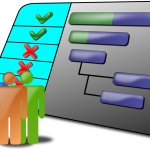Four Risk Management Techniques for Project Managers
There is no growth and success without proper risk management. A project manager has to be able to tackle emergency situations and handle risks with effective strategies. Otherwise, your project is doomed to failure.
The October Software C-level staff is primarily made of people with project management experience. Even more, we have reliable partners like Rambøll that know a lot about managing risks. Today, we’re sharing some of our expertise with you.
What Is Risk Management?
As the name itself gives away, the main purpose of project risk management is to save a project from risks or minimize their effects by identifying them before they affect the whole project. Being ready for any uncertain or unexpected situation and handling the possible consequences is what project risk management is all about.
The type of risks may vary from one project to another. By analyzing past events and the nature of the project, a project manager can ensure that there is no possibility of a situation which can cause a disaster.
At October Software, we know exactly how important risk management is for any project. This is why our software makes it easy for you to identify risks and mitigate them in time.
However, we also know that risk management doesn’t come easy. So we’re prepared to help you with theoretical resources on top of our software.
Check out the risk management techniques you can start implementing right now. Thank us later when your projects get streamlined and free of major risks.
Identifying Risks
Thinking of risk as a sudden occasion is a misconception. Recognizing an issue and examining it ahead of time is the best way to start the risk management process.
The idea behind this procedure is to perceive, reveal and depict risks that could influence the result of your project and that could help minimize any negative consequences.
There are a lot of steps in the process of identifying risks: brainstorming, risk surveys, facilitated workshops, event inventories or data loss interviews and self-assessments, SWOT analysis, root cause and checklist analysis, expert judgment, influence diagrams, and assumption analysis.
In other words: this process never ends. We don’t mean to sound dramatic. But risk identification is an on-going process and an evaluation has to be completed every month.
How to Do a Qualitative Risk Analysis
After you are done with identifying risks for your project, you need to start a qualitative risk analysis. While you are carrying it out, you need to filter out which risks can cause more potential harm to the project and which can be ignored for the time being.
This is basically a process of curating a list of possible risks and giving them ranks as per the effects they can have so that you can divert more of your time and energy on handling risks that can cost you the entire project.
You can rely on these three steps to make sure your qualitative risk analysis is actually worth your time:
- Risk Grouping
What you need to do here is categorize the risks based on their common root causes to help manage them better.
- Risk Assessment
When you have a rundown of potential project risks, you have to figure out which of them should be overseen. By and large, those risks that can affect the project the most and those that will are most likely to happen are the ones that you should focus on.
A fundamental risk assessment will investigate each risk occasion for the probability that the risk will happen and for the effect it will have in the event that it happens. This sort of qualitative risk investigation data can be plotted on a risk assessment matrix that joins the risk rating rules as characterized in your Project Risk Management Plan.
Quantitative risk management techniques can also be utilized. These strategies incorporate the Monte Carlo strategy, affectability examination, and expected fiscal investigation.
- Expert Judgment
Outside help can always be beneficial. And expert risk manager can always help you identify risk faster. Better yet, a new, objective set of eyes on your project can reveal a lot of valuable insights.
How to Do a Quantitative Risk Analysis
The quantitative risk analysis helps you in assessing the money loss that a risk can cause to a project. It also involves multiple steps:
a. Probability Distributions
It is used to monitor the uncertainty of values in things like labor costs and task expenses. It helps in checking where the extra money goes.
b. Sensitivity Analysis
This technique lets you measure how much impact and effect a single risk can have on your project
c. Expected Monetary Value Analysis (EMV)
This is a technique where you calculate the expected or average outcome of situations influenced by risks in a project.
Risk Response Development
The three most common risk response methods in project management are:
- You can avoid a risk simply by introducing some changes in your strategy or plan.
- A risk can also be handed over to a third party which takes responsibility for it (for a fee, of course). For example: insurance, warranty and so on.
- You can train your staff accordingly to make them work in a way which leaves no space for a dangerous risk to appear.
Need to know more about how Project Reader can help you identify and mitigate risks? Schedule a call or a demo with our customer service – we’d love to help you!



